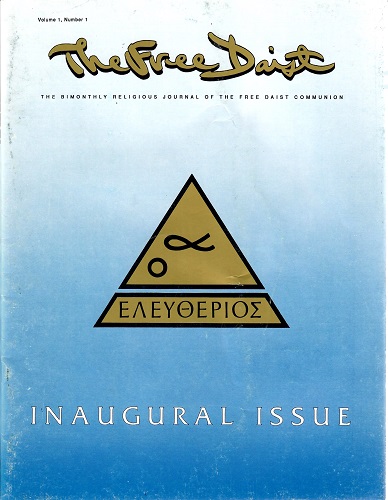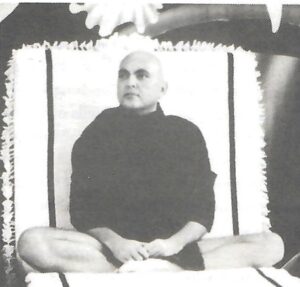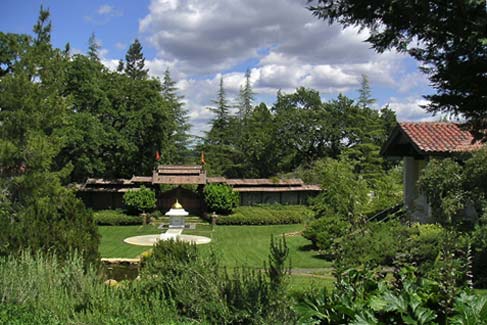Originally published in
The Free Daist
The Bimonthly Religious Journal of the Free Daist Communion
Volume 1, Number 1


Many years ago Heart-Master Da Love-Ananda used the term “the Vision of Mulund” as a symbol of genuine human community, and He Gave the name to community organizations in the Way of the Heart. In a Talk given on July 2,1988, Heart-Master Da described in detail His original Vision in the town of Mulund in India some twenty years ago, and reminds us that the Calling into His Company is also a Calling to the Sangha, for true religion and community “have always been associated with one another since the ancient days “.

“you are called to live the practice in community”
DEVOTEE: Heart-Master Da, thank You for the invitation to be here at The Mountain Of Attention today. I want to ask You to speak about the form of the community around here that would please You. I remember Your saying that the village of Mulund struck You as being a beautiful place in some ways, and I guess You wanted to see something like that develop here.
HEART-MASTER DA LOVE-ANANDA: Who did we hear developed the village of Mulund? Were they Parsis? Jains? In either case, the same point can be made. The Parsis are modern Zoroastrians, and both they and the Jains in India live in community. They are very much aware of themselves as a Sangha, in other words. They understand the value of the Sangha, or the community of serious practice. Instead of just living scattered about, renting a room here or a house there, they collect into areas and live together. They can therefore change the whole quality of the place, you see, because they own it. They can live there as they please. They can generate all the qualities associated with their religious way of life there – whereas if you simply live scattered about all over the place, always the quality of your life and the quality of the world in which you live is determined by other people. It is as the world would have it. But if you live in community together, you can choose all the qualities of your environment.
The only places we have where that choice can be entered into directly, at least at the present time, are the Sanctuaries, such as this one. If you had the will and the resources, you could make profound changes even in the quality of this place, which you find beautiful already. Even so, you are called to live the practice in community, not because community itself is some sort of ideal or utopian circumstance or even possibility. The living community is a form of sadhana. Its purpose, then, is self-transcendence and God-Realization ultimately. Those who live this sadhana of cooperation in community with one another are animating their commitment to self-transcending God-Realization, and they are serving that possibility in one another.
First of all, then, that is what I look to see, that purpose animated by you all. That purpose animated would do many things in terms of your personal practice and in terms of all your obligations as a gathering of practitioners. Along with that come many other things you can do with one another to differently manage the circumstances and environments of life and differently manage the practical details of life in a way that reclaims your energy and attention from ordinary occupation and allows it to be devoted to sadhana, yes, but also\to the greater aspects of the Spiritual Process. That is another sign I would look for once there is this commitment and all the actions that would come from it. I look for you to make such changes first. I look for you to retrieve for yourselves energy and attention for the Spiritual Process, and to retrieve yourselves from the world in that sense, then.
Beyond that, as in Mulund in India, you can generate any number of practical signs, on the basis, however, of self-transcending sadhana and maximizing your involvement in the greater aspects of the Spiritual Process. Those are the basic signs. But once those are intact, then there are any number of practical signs you can generate, not only in Sanctuaries, but also in your life in community with one another.
Now the town of Mulund – which I haven’t been to for twenty years, so I don’t know what it looks like anymore -the town of Mulund as a whole was not so beautiful. It wasn’t the entirety of Mulund that was beautiful. What was remarkable about it, apart from the fact that I entered into Nirvikalpa Samadhi twice on that day [laughter], was that to get there required traveling country-style on trains loaded with people all over one another and arriving in what appeared to be a little dirt-road village with crowds of people. It wasn’t a beautiful place. I walked across the railroad tracks into this very typical, little, ordinary dirt-road village and carried all our luggage down the streets from the railroad area to what I suppose you would call an apartment building, where several families had rather small apartments. It was something like three stories high, I think – not a glamorous building in any sense whatsoever, but a simple little country road apartment building.
Having arrived there after this dusty trip, as I recall, I took a shower. And as I was coming out from the shower, which I believe was in a little bathroom in the hallway, I noticed a stairway and I just spontaneously walked up and onto the roof. I don’t think I was even told there was a roof to look out from. I just walked up, and as I came to the top of the stairs and onto the roof, the orientation was to the back of the building, whereas I had approached from the front and the little crowded, noisy town. Looking out in the opposite direction from the roof, then, I saw a completely different physical environment than I had encountered there before
There was no way to presume that anything like what I saw existed in this town. It was a large square with green at the perimeter. Everything was cleanly trimmed. There were decorative trees and plants and flowers everywhere, and walkways through a large park where a few people were calmly walking about, all of them very crisply, cleanly dressed in a style of clothing I suppose is characteristic of this group. They were all well washed and clean in their nice evening dress – families, women and children, and men walking together very calmly. No sound. No noise at all in the park -whereas it was all noise beyond at the front side.
It was a picture of serenity and order, of people who had their act together, people who could choose a way of life and by cooperation with one another command the quality of life. This is quite different from what you see elsewhere, in little dirt-road towns like San Francisco and so on [laughter], with all the noise and chaos of “put up with whatever your neighbor feels like doing” and “we all just do our thing.” Typically the way is that everybody puts up with what everybody else is doing, you see. You put up a picture or a little vase of flowers, and put in earplugs, and try in your sheerest privacy in the smallest space that you can call your own, to create something of the signs or the order of your own choosing. Very few people get to choose together an order, a Way of life that is based on the Truth. Rather, everyone is wandering, doing their thing, ego-wise, and disturbing everyone else.
One of the virtues, then, of choosing to practice together is that you can command the quality of space and time, at least on a much larger scale than you could otherwise, and more surely. If you do that, then your environments, including our Sanctuaries, can become beautiful places where that order, that serenity, that quality of life, is shown, as well as places that are a sign of Godwardness and Divine Awake-ness, or the Process that Awakens toward God and in God, and ultimately as God.

This Sanctuary, if you don’t look at it too closely [laughter], has some of the qualities of the village of Mulund. It has some quality of orderliness, and green grasses and green trees, particularly at this time of year. You are called to bring an order to life here, to live “Ashram Dharma” here. You are called to a quality of life here. You are not merely called to a place. Something of Mulund is lived here when you come here, therefore, and apparently quite a bit less of Mulund has been lived by you all elsewhere.
“An inevitable discipline, then, is community, if you awaken beyond the principle of egoity”
You are called to My Company and you are called to the Sangha. You are called to practice this Way of life and to change your life, and to do so with one another. And if you do all of that, then the qualities of existence can change. Those changes are not for their own sake. They are simply the inevitable expressions, or signs, people make when they live lawfully. Of course, the process itself transcends all possible conditional signs ultimately, but together you all can live very differently than you are obliged to live in the common world. This is why religious people have traditionally chosen to live in community. In fact, religion and community are necessarily associated with one another, and have always been associated with one another since the ancient days. It is particularly in the egoic Western world, the “omega” Western world, that religion has gotten divorced from the community. It is basically here that this has occurred, at least so dramatically. People think religion is basically some private, internal process of self-consolation and so on. They do not think that the process associated with real religion has anything to do necessarily with community. Community is rather something you can maybe add if you feel like it.
But the sadhana of the religious life, and ultimately of the Spiritual life, is necessarily associated with community. In other words, it impinges on your life of relatedness and requires the discipline in relationship, requires you to discipline egoity in the context of relationship, egoity and separatedness, self-isolation. An inevitable discipline, then, is community, if you awaken beyond the principle of egoity. You cure egoity, transcend it, work beyond it through the discipline of community or the opportunity to do that most creatively and effectively with those who are similarly inclined to this Way of life. You must express that disposition in all relationships. You must overcome yourself, transcend yourself in all relationships.
■
From
Mulund, one of the earliest planned suburbs of Mumbai and also the end of Mumbai. It’s a land of skyscrapers and gardens and is the last railway station of the Mumbai district on the central line. So what to do if you are here for a day?
1. Yogi Hills
2. Chintamani Gardens
3. Sambhaji Ground
4. Bhandup Pumping Station
